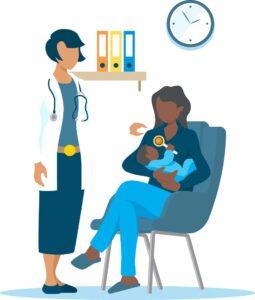Working together to advance maternal health equity
The United States is in the midst of a maternal health crisis. New and expectant mothers face increasing rates of both pregnancy and childbirth-related complications, and are more than two times as likely to die from these complications compared to women in most other high-income countries.1 The health disparities are disproportionately and unacceptably high among pregnant women of color. Women in majority Black and Hispanic communities face 63 percent and 32 percent higher rates, respectively, of severe maternal morbidity (SMM) than women in majority white communities.*2
With women encompassing nearly half of the workforce, and 85 percent of them becoming mothers during their careers, these disparities have serious implications for employers.3 The need to build a new, more equitable model of healthcare has never been more urgent. But we need your help—because closing these disparity gaps and improving maternal health takes all of us.
*Among women with employer-sponsored health insurance.
What is SSM?
Severe maternal morbidity, or SMM, measures unexpected outcomes from labor and delivery with significant short- or long-term consequences to a woman’s health.4 The Centers for Disease Control and Prevention categorizes SMM by 21 different adverse advents, known as “indicators.”5 In some cases, an SMM indicator can be associated with maternal death.6
Maternal health equity: scale of impact
Grasping the extent of maternal health disparities is the first step in being able to provide support to expectant mothers in your workforce.
Preconception
- Women in majority Black communities have up to 2x the prevalence of risk factors for SMM,* such as hypertension or anemia, as women in majority white communities.7
- Women in majority Hispanic communities have up to 33% higher prevalence rates of some risk factors for SMM,* such as prior cesarean birth and preexisting diabetes, compared to women in majority white communities.8

- Rates of severe illness are higher among pregnant women in the Northeast and South, those from lower-income communities and those giving birth in public hospitals.9
*Among women with employer-sponsored health insurance.
Pregnancy
- A review by the American Diabetes Association reported that Asian/Pacific Islander women exhibit the highest prevalence of gestational diabetes (14.8%), which can increase pregnancy complications.10
- Native Hawaiian and other Pacific Islander women are five times more likely than white women to not begin receiving prenatal care until the third trimester or to receive and prenatal care at all. Hispanic women are twice as likely compared to white women to have a birth with late or not prenatal care.11
- The risk for miscarriage is roughly 43% higher for Black women compared to white women.12
Labor & delivery
- Black women have pregnancy-related mortality rates that are over 3x higher compared to the rate for white women.13 And pregnant Black women are 45% more likely to die in the hospital.14
- Prevalence of delivery complications is 46% higher among Black mothers versus white mothers.15 Even after adjusting for socioeconomic status, access to healthcare and other medical conditions, researchers found that compared to white women, pregnant Black women were: 57% more likely to have a stroke; 42% more likely to develop a blood clot in the lungs; and 71% more likely to develop heart muscle weakness.16 These outcomes are more likely to occur at or near the time of labor and delivery.
Postpartum
- Early and consistent screening combined with the context of known risk factors has been found to help detect and treat postpartum depression.17 But according to a recent survey from Blue Cross Blue Shield (BCBS), 34% of Hispanic women said they were not screened for postpartum depression or did not know if they were screened.18
- Based on an analysis of BCBS claims data for women with employer-sponsored health insurance, nearly half (45%) of women diagnosed with postpartum depression went untreated during the 2019-2020 time period. Among those who receive treatment, only 52% of Black women and 49% of Hispanic women were treated compared to 57% of white women. These gaps in treatment are due, for the most part, to disparities in the adoption of prescription treatment, which was 39% for white women, but only 28% for Black and Hispanic women.19
Impact on employers
A majority of women in the workplace will become mothers during their careers, and 50,000 women suffer life-threatening pregnancy complications each year.20 These risks are especially high for women of color. This can have a huge impact on the health and overall well-being of your employees, their families and your business. To help advance maternal health equity, employers can support improving access to quality care.
Understanding maternal health disparities
When addressing the many complex, interrelated reasons for maternal health disparities, it’s important to understand the impact of social determinants of health (SDoH) on health equity and how they affect maternal health. Below are a few key influencing factors.
Provider bias and inequality of care
Healthcare providers can have both conscious and unconscious bias when treating people of different backgrounds. Approximately a third of Black people report being racially discriminated against when going to a doctor or health clinic.21 A BCBS survey showed that as compared to white and Hispanic mothers, Black mothers report feeling their provider did not spend enough time with them, have lower confidence they will receive the care they need and feel like they cannot openly speak to their provider about their pregnancy.22

Lack of access to care
People of color have less access to quality care from contraception to postpartum.23 Regular prenatal care can reduce the risk of pregnancy complications.24 In addition, compared with white mothers, mothers of color say they were not always able to complete the recommended series of prenatal visits, mainly because of a lack of transportation or scheduling conflicts.25 Furthermore, Black mothers are more likely to face greater financial barriers to care than white mothers.26 COVID-19, which disproportionately affects people of color, has also played a role in reducing prenatal visits.27
Chronic conditions and weathering
Women in communities of color face much higher prevalence rates of underlying chronic conditions that are risk factors for SMM, such as preexisting diabetes (Black 62 percent, Hispanic 38 percent) and anemia, than women in majority white communities.28 Women of color also experience “weathering,” or an increased vulnerability to health risks due to the constant stress of encountering racism. This makes pregnancy riskier, as experiencing racism and prenatal stress are linked to adverse birth outcomes, such as low birthweight and preterm delivery.29
What we can do together
Women with employer-sponsored health insurance account for over half of the annual pregnancies in the United States.30 This puts employers and health plan partners in a unique position to positively impact maternal health by exploring benefit design options, involving local communities and fostering a supportive and inclusive workplace culture.
Explore expanding benefits and strengthening networks
Collaborate with your health plan partner to improve access to higher-quality more affordable maternal care.
- Explore Maternity Centers of Excellence – Ask your health plan partner to identify accredited programs that are evaluated for data collection, patient outcomes, cultural competence and drills for serious maternal adverse events.31
- Expand supportive services throughout the maternal journey – Encourage health plan partners to increase affordable access to trauma-informed health professionals, doulas, midwives, community health workers, perinatal care managers and maternal health coaches by bringing them into networks. Address cost and transportation barriers through onsite and virtual care offerings.
Collaborate with communities
Engage with your local community to build an expansive support system.
- Learn about what is essential to your employees – Find out what services your employees are interested in, and work with your health plan partner to connect with community groups supporting those needs.
- Come together to drive change – Support, fund and share community outreach programs—from local community-focused groups to faith-based partnerships—that provide birthing mothers with health education and resources, while also building trust with providers.32
Create culturally competent workplaces
Communicate openly to educate your workforce about maternal health disparities.
- Get leaders to speak out – Encourage senior leaders to be vocal about the critical need for maternal health equity, and drive education on the importance of prenatal and postpartum screenings, as well as the potential adversities of elective inductions and unnecessary cesareans.33
- Embrace cultural awareness holistically – Cultural humility, an ongoing willingness to learn, is of utmost importance and needs to permeate efforts. Commit to an organizational culture and business practices that promote diversity, equity and inclusion (DEI).34
1 Roosa Tikkanen, et al., Maternal Mortality and Maternity Care in the United States Compared to 10 Other Developed
Countries, The Commonwealth Fund, Nov. 18, 2020.
[footnote]2, 6, 7, 8, 22, 25, 27, 28 Blue Cross Blue Shield Association, The Health of America Report, “Racial Disparities in
Maternal Health,” May 20, 2021.
3 Bryan Robinson, “Pregnancy Discrimination In The Workplace Affects Mother And Baby Health,” Forbes, July 11, 2020.
4 American College of Obstetricians and Gynecologists and the Society for Maternal-Fetal Medicine; Sarah K. Kilpatrick
and Jeffrey L. Ecker, “Severe Maternal Morbidity: Screening and Review,” American Journal of Obstetrics and Gynecology,
215(3), B17-22, Sept. 2016.
5 Division of Reproductive Health, National Center for Chronic Disease Prevention and Health Promotion, “Reproductive
Health: Severe Maternal Morbidity in the United States,” Centers for Disease Control and Prevention, Feb. 2, 2021.
9 Eugene Declercq and Laurie Zephyrn, Severe Maternal Morbidity in the United States: A Primer, The Commonwealth Fund,
Oct. 28, 2021.
10 Gianna Melillo, “Racial Disparities Persist in Maternal Morbidity, Mortality and Infant Health,” AJMC, June 13, 2020.
11, 13 Samantha Artiga, et al., Racial Disparities in Maternal and Infant Health: An Overview, KFF, Nov. 10, 2020.
12 Tori B. Powell, “Black Women Are at Higher Risk for Miscarriage, Study Finds,” CBSN, Apr. 29, 2021.
14, 16 “Black Women Have the Highest Risk of Pregnancy-Related Heart Problems in the US,” American Heart Association,
Dec. 16, 2020.
15 Blue Cross Blue Shield Association. Health of America, Maternal Health Data. 2020.
17 Zoleykha Asgarlou, Mohammad Arzanlou, and Mohammad Mohseni, “The Importance of Screening in Prevention of Postpartum
Depression,” Iranian Journal of Public Health, May 2021, 1072–1073, cited in National Center for Biotechnology
Information/US National Library of Medicine, National Institutes of Health.
18 Blue Cross Blue Shield Association, Maternal Health Survey. 2020.
19 Blue Cross Blue Shield Association, Analysis on Postpartum Depression. 2022.
20, 30, 33 Suzanne Delbanco, et al., “The Rising U.S. Maternal Mortality Rate Demands Action from Employers,” Harvard
Business Review, June 28, 2019.
21 “Poll Finds at Least Half of Black Americans Say They Have Experienced Racial Discrimination in Their Jobs and from
the Police,” Harvard T. H. Chan School of Public Health, Oct. 24, 2017.
23, 29, 31, 32, 34 “Well-being and Workforce Strategy: Ending Disparities in Maternal Mortality,” Business Group on
Health, April 14, 2021.
24 Office of Communications, What Is Prenatal Care and Why Is It Important? National Institute of Child Health and Human
Development, Jan. 31, 2017.
26 Black Women’s Maternal Health: A Multifaceted Approach to Addressing Persistent and Dire Health Disparities, National
Partnership for Women & Families, Apr. 2018.